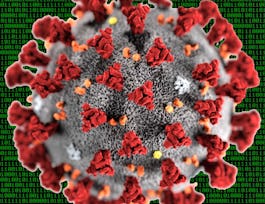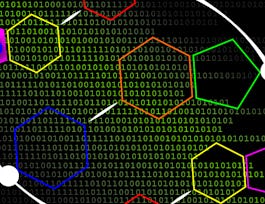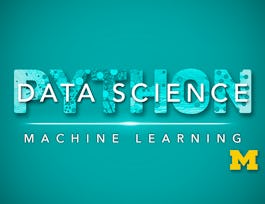A big welcome to “Bioinformatics: Introduction and Methods” from Peking University! In this MOOC you will become familiar with the concepts and computational methods in the exciting interdisciplinary field of bioinformatics and their applications in biology, the knowledge and skills in bioinformatics you acquired will help you in your future study and research.



Bioinformatics: Introduction and Methods 生物信息学: 导论与方法


Instructors: Ge Gao 高歌, Ph.D.
Sponsored by Syrian Youth Assembly
46,640 already enrolled
(272 reviews)
Skills you'll gain
Details to know

Add to your LinkedIn profile
13 assignments
See how employees at top companies are mastering in-demand skills


Earn a career certificate
Add this credential to your LinkedIn profile, resume, or CV
Share it on social media and in your performance review

There are 14 modules in this course
Welcome to “Bioinformatics: Introduction and Methods! Upon completion of this module you will be able to: become familiar with the essential concepts of bioinformatics; explore the history of this young area; experience how rapidly bioinformatics is growing. Our supplementary materials will give you a better understanding of the course lectures through they are not required in quizzes or exams
What's included
4 videos2 readings1 assignment
Upon completion of this module, you will be able to: describe dynamic programming based sequence alignment algorithms; differentiate between the Needleman-Wunsch algorithm for global alignment and the Smith-Waterman algorithm for local alignment; examine the principles behind gap penalty and time complexity calculation which is crucial for you to apply current bioinformatic tools in your research; experience the discovery of Smith-Waterman algorithm with Dr. Michael Waterman himself.
What's included
7 videos2 readings1 assignment
Upon completion of this module, you will be able to: become familiar with sequence databse search and most common databases; explore the algoritm behind BLAST and the evaluation of BLAST results; ajdust BLAST parameters base on your own research project.
What's included
3 videos2 readings1 assignment
Upon completion of this module, you will be able to: recognize state transitions, Markov chain and Markov models; create a hidden Markov model by yourself; make predictuions in a real biological problem with hidden Markov model.
What's included
4 videos2 readings1 assignment
Upon completion of this module, you will be able to: describe the features of NGS; associate NGS results you get with the methods for reads mapping and models for variant calling; examine pipelines in NGS data analysis; experience how real NGS data were analyzed using bioinformatic tools. This module is required before entering Module 8.
What's included
8 videos2 readings1 assignment
Upon completion of this module you will able to: describe what is variant prediction and how to carry out variant predictions; associate variant databases with your own research projects after you get a list of variants; recognize different principles behind prediction tools and know how to use tools such as SIFT, Polyphen and SAPRED according to your won scientific problem.
What's included
6 videos2 readings1 assignment
The description goes here
What's included
1 assignment
Upon completion of this module, you will be able to: describe how transcriptome data were generated; master the algorithm used in transcriptome analysis; explore how the RNA-seq data were analyzed. This module is required before entering Module 9.
What's included
5 videos2 readings1 assignment
Upon completion of this module, you will be able to: Analyze non-coding RNAs from transcriptome data; identify long noncoding RNA (lncRNA) from NGS data and predict their functions.
What's included
6 videos2 readings1 assignment
Upon completion of this module, you will be able to: define ontology and gene ontology, explore KEGG pathway databses; examine annotations in Gene Ontology; identify pathways with KOBAS and apply the pipeline to drug addition study.
What's included
8 videos2 readings1 assignment
Upon completion of this module, you will be able to describe the most important bioinformatic resources including databases and software tools; explore both centralized resources such as NCBI, EBI, UCSC genome browser and lots of individual resources; associate all your bioinformatic problems with certain resources to refer to.
What's included
6 videos1 reading1 assignment
Upon completion of this case study module, you will be able to: experience how to apply bioinformatic data, methods and analyses to study an important problem in evolutionary biology; examine how to detect and study the origination, evolution and function of species-specific new genes; create phylogenetic trees with your own data (not required) with Dr. Manyuan Long, a world-renowned pioneer and expert on new genes from University of Chicago.
What's included
5 videos2 readings1 assignment
Upon completion of this case study module, you will be able to: experience how to use bioinformatic methods to study the function and evolution of DNA methylases; share with Dr. Gang Pei, president of Tongji University and member of the Chinese Academy of Science, the experiences in scientific research and thought about MOOC.
What's included
5 videos1 reading
The description goes here
What's included
1 assignment
Instructors


Offered by
Why people choose Coursera for their career




Learner reviews
272 reviews
- 5 stars
65.93%
- 4 stars
21.61%
- 3 stars
5.86%
- 2 stars
2.93%
- 1 star
3.66%
Showing 3 of 272
Reviewed on Oct 9, 2019
This course is extremely useful and has inspired me to continue to learn bioinformatics. Both context and practice presentation are concise and understandable.
Reviewed on Apr 30, 2020
建议直接上B站看翻译的中文版本,入门确实比较困难,如果没有计算机基础的医学生还是斟酌一下时间性价比。高/魏两位教授能够深入浅出地讲授核心的概念,但是本质上Bioinformatics还是一门实践课程,希望以后我以后运用bioinfo相关知识时,不会忘记这里给我的启蒙。
Recommended if you're interested in Health

University of California San Diego

Johns Hopkins University

University of Michigan

Open new doors with Coursera Plus
Unlimited access to 10,000+ world-class courses, hands-on projects, and job-ready certificate programs - all included in your subscription
Advance your career with an online degree
Earn a degree from world-class universities - 100% online
Join over 3,400 global companies that choose Coursera for Business
Upskill your employees to excel in the digital economy



